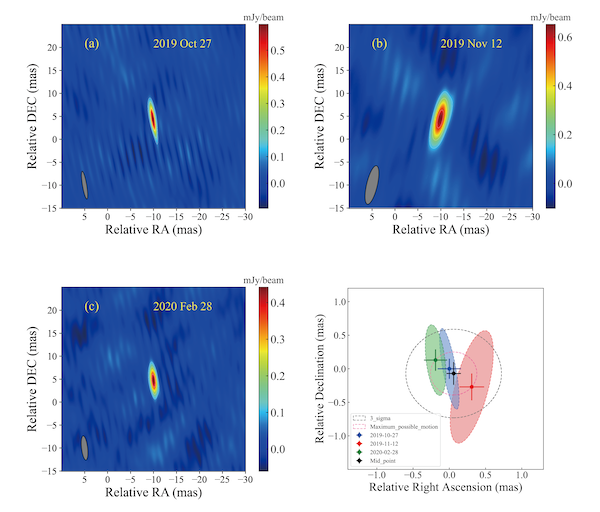
High-resolution VLBI observations and modelling of the radio emission from the TDE AT2019dsg
by Prashanth Mohan (SHAO, China), Tao An (SHAO, China), Yinkang Zhang (SHAO, China), Jun Yang (Chalmers, OSO, Sweden), Xiaolong Yang (SHAO, China) and Ailing Wang (SHAO, China)

observations showing a compact, unresolved source. Bottom right: constraints on the source;
emission centre from astrometric measurements the inner red circle denotes the
maximum relative position change, and the outer black circle denotes the 3-sigma error
on this, indicating no significant proper motion.
A tidal disruption event (TDE) involves the cataclysmic shredding of a star that approaches the vicinity (at or within the tidal radius) of a galactic supermassive blackhole (SMBH of a million - 100 million times the solar mass, e.g. Rees 1988, Evans & Kochanek 1989). The accreting stellar debris powers a predominantly optical — X-ray flare (thermal blackbody emission) during the early phase (timescale of days, e.g. Saxton et al. 2020). An outflow (relativistic/collimated or non-relativistic/wider angled) can be subsequently produced and accelerated. Synchrotron radio emission is produced by electrons accelerated by an expanding shock (over timescales of months to years, e.g. Alexander et al. 2020). The shock can originate 1) from the interaction between the outflow and the surrounding circum-nuclear medium, and 2) can be intrinsic to the outflow (e.g. injection events, magnetic re-connections in the relativistic jets of active galactic nuclei AGN). Monitoring the radio emission can address its origin, outflow nature (relativistic or non-relativistic), constrain the density and distribution of the surrounding environment, and help discern the TDE physical and geometric properties (e.g. Alexander et al. 2020).
AT2019dsg is a TDE discovered on 9 April 2019 by the Zwicky Transient Factory at a redshift z = 0.051 (distance of ~ 230 Mpc; van Velzen et al. 2021). It is highly luminous (peak optical luminosity of ~ 3.51044erg/s) and the first TDE with a potential neutrino association (peta-electron volt, PeV) based on the detection by the IceCube neutrino observatory (IC191001A ~ 180 days post TDE; Stein et al. 2021). The study of non-thermal emission (evolution of flux density and source structure) and its origin, either from activity associated with a relativistic jet (collimated, beamed emission) or a non-relativistic outflow (wider angled) is key to understanding the origin of the PeV neutrino from this source. Multi-wavelength and interpretational studies of AT2019dsg provided divergent views on the nature of the emission and hence on the neutrino origin (see for e.g. Stein et al. 2021, Winter & Lunardini 2021, Cendes et al. 2021).
Our Very Long Baseline Interferometry (VLBI) high resolution C-band radio observations (5 GHz) were conducted with telescopes from the European VLBI Network (EVN; that can resolve emitting structures a few tens of light-years in the host galaxy situated ~ 750 million light-years away). This included three sessions (RSM04, EM140A and EM140B covering ~ 4 months during 2019 — 2020) and involved up to 20 participating radio telescopes across the UK, Europe, Russia and China. The objectives were: 1) To detect and monitor the radio emitting component and its evolution (in brightness and structure), 2) To potentially detect a relativistic jet (putatively driving the production of neutrinos and cosmic rays in blazars, a type of AGN), and 3) Inputs to discern the TDE properties and address the neutrino association. The observations successfully imaged the compact fading emission structure in all three sessions (see Figure 1), enabling the integration with previous C-band studies in order to aid in the modelling of the emission and understanding its origin.
The EVN astrometric measurements (precise position of the emission peak) and flux density evolution provide less evidence for a relativistic component in AT2019dsg (at the 3-sigma uncertainty level, see Figure 1). This and modelling the evolution of the 5 GHz radio flux densities indicate a decelerating shock produced by a fast outflow with a speed of ~ 0.1c that had interacted with a dense surrounding medium. The transient involved the disruption of a ~2 solar mass star. The base of the outflow is found to offer suitable conditions for the production and acceleration of cosmic ray protons and neutrinos. The findings promote an expanded inventory of multi-messenger (electromagnetic, particles: cosmic rays and neutrinos, gravitational waves) producing transients, not necessarily requiring a powerful accelerating mechanism such as a relativistic jet.
Published in: Mohan et al., 2022, ApJ, 927, 74